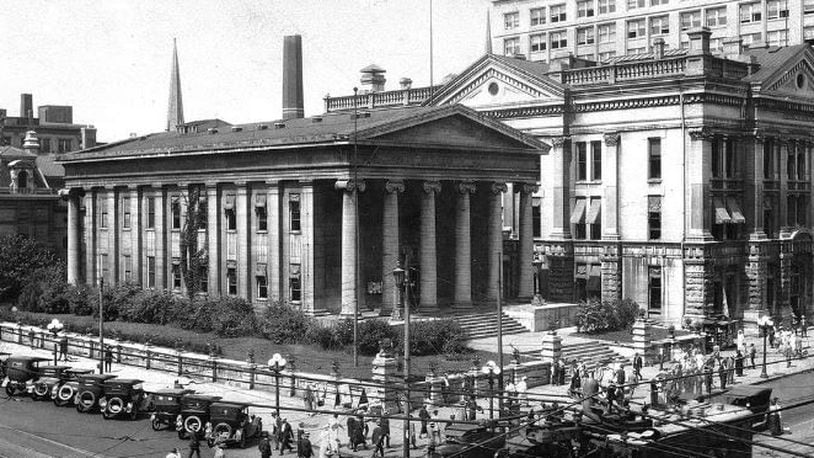The history
Construction on the Old Montgomery County Courthouse began in 1847, and it opened on April 16, 1850.
The building, which was constructed for $100,000, is located on the northwest corner of Third and Main streets in downtown Dayton.
The city’s first railroad tracks were laid to help mule teams transport the structure’s limestone slabs from quarries outside town.
On its first day, the building was crowded with spectators as Judge John Beers entered the courtroom accompanied by Robert Brown, one of the three associate justices, Sheriff David Clark and Prosecuting Attorney Samuel Craighead.
The first judicial act of the court was the swearing-in of 15 men to a grand jury.
The first civil action taken in the courthouse was the appointment of a guardian for two children.
During the Civil War, Daytonians gathered at the courthouse for telegraph updates.
The Architecture
Dayton’s Old Courthouse is considered one of the finest examples of Greek-Revival architecture in the nation.
The building is patterned after the Theseum in Athens, Greece, a temple dedicated to Hephaestus and Athena. It has graceful white stone pillars with cast iron lamps and massive wrought iron doors, each weighing more than a ton.
Credit: Lisa Powell
Credit: Lisa Powell
Michael Sandy, a geology professor at the University of Dayton, determined the structure was made from limestone that was 430 million years old. The courthouse stone is a unique variety known as Dayton limestone, partially because of its blend of sedimentary materials. It was given its name because it was quarried only in the immediate vicinity of Dayton.
The interior floor plan was modeled after a traditional Greek temple and included a high ceiling vestibule, center hall procession that led to a rotunda and elliptical courtroom.
It was the first building in Dayton equipped with gas lamps and running water.
Presidential visits
Presidents Abraham Lincoln, Andrew Johnson, James Garfield, John F. Kennedy, Lyndon B. Johnson, Richard Nixon, Gerald Ford, Ronald Reagan and Bill Clinton have all made speeches on this site.
Lincoln made an anti-slavery speech on the steps of the courthouse on Sept. 17, 1859. An 11-foot-tall bronze sculpture of Lincoln was unveiled in Dayton’s Courthouse Square in front of the courthouse on the anniversary of the speech in 2016.
Nixon gave a 25-minute stump speech at the courthouse to a crowd of 5,000 in 1968. Nixon said, “This is the home of the cash register, so I want to tell you that the American people are going to ring up ‘No Sale’ on Hubert Humphrey on Nov. 5.”
In 1984, Ronald Reagan flew from Washington, D.C., to Wright-Patterson Air Force Base and opened his day with a campaign speech at the courthouse.
Courthouse annex
In 1884, a new courthouse was built next to the original courthouse. The two courthouses stood side by side, encompassing a block of downtown Dayton for many years.
These two buildings functioned as the Montgomery County courthouse until the 1960s when the modern Montgomery County Courthouse was completed at 41 N. Perry St.
Almost sold
In the late 1940s, another courthouse was being planned and county commissioners wanted to sell the historic courthouse. The historical society objected and took the issue to the Ohio Supreme Court.
The historical society, known in the lawsuit as “friends of the court,” argued that the land on which the courthouse was built was given in trust by Daniel C. Cooper, and the building could not be sold without consent of the Ohio legislature.
The county commissioners claimed they held the title for the land and had the authority to sell it.
In 1949, the Ohio Supreme Court upheld the ruling of two lower courts in determining that the Montgomery commissioners held absolute title to the old courthouse.
For several years after, the fate of the old courthouse was in limbo. Over time, the idea of selling or tearing down the old courthouse became unpopular.
The idea of turning the building into a museum, however, became more favored.
A museum
In 1963, the Montgomery Historical Society moved in and plans to transform the site into a museum moved forward.
In the early 1970s, the historical society launched a $500,000 fund drive to pay for the restoration of the Dayton landmark and its conversion to a “living museum.”
A private foundation grant of $33,000 enabled the society to restore the two-story, domed courtroom to its original, 19th century grandeur. Plans called for the courtroom to serve as the main exhibition gallery and lecture hall. The restoration included the installation of a sound system and carpeting.
The second floor had offices, a library and a laboratory for restoring antiques. The basement was used for storage.
Today, many of the items once housed at the Old Montgomery County Courthouse Museum can be found at Carillon Historical Park.
The Gem Plaza
Originally called Gem Plaza, the area around the Old Montgomery County Courthouse is now known as Courthouse Square.
Credit: JIM NOELKER
Credit: JIM NOELKER
In August of 1973, construction began on the L-shaped area around the courthouse to convert it into a public plaza that is now known as Courthouse Square. Architectural plans for the plaza included trees, benches, a fountain and an ice-skating rink.
To make room for the plaza, the “new” Montgomery County Courthouse building was torn down.
Today, many community events are held in the space, which often include food trucks and other vendors.
Courthouse today
Today the Old Courthouse is owned by Montgomery County. The newly renovated Old Montgomery County Courthouse was re-dedicated with a ribbon cutting on May 6, 2005.
Since the $4 million restoration, the building is now used for public and private meetings and special events.
About the Author
